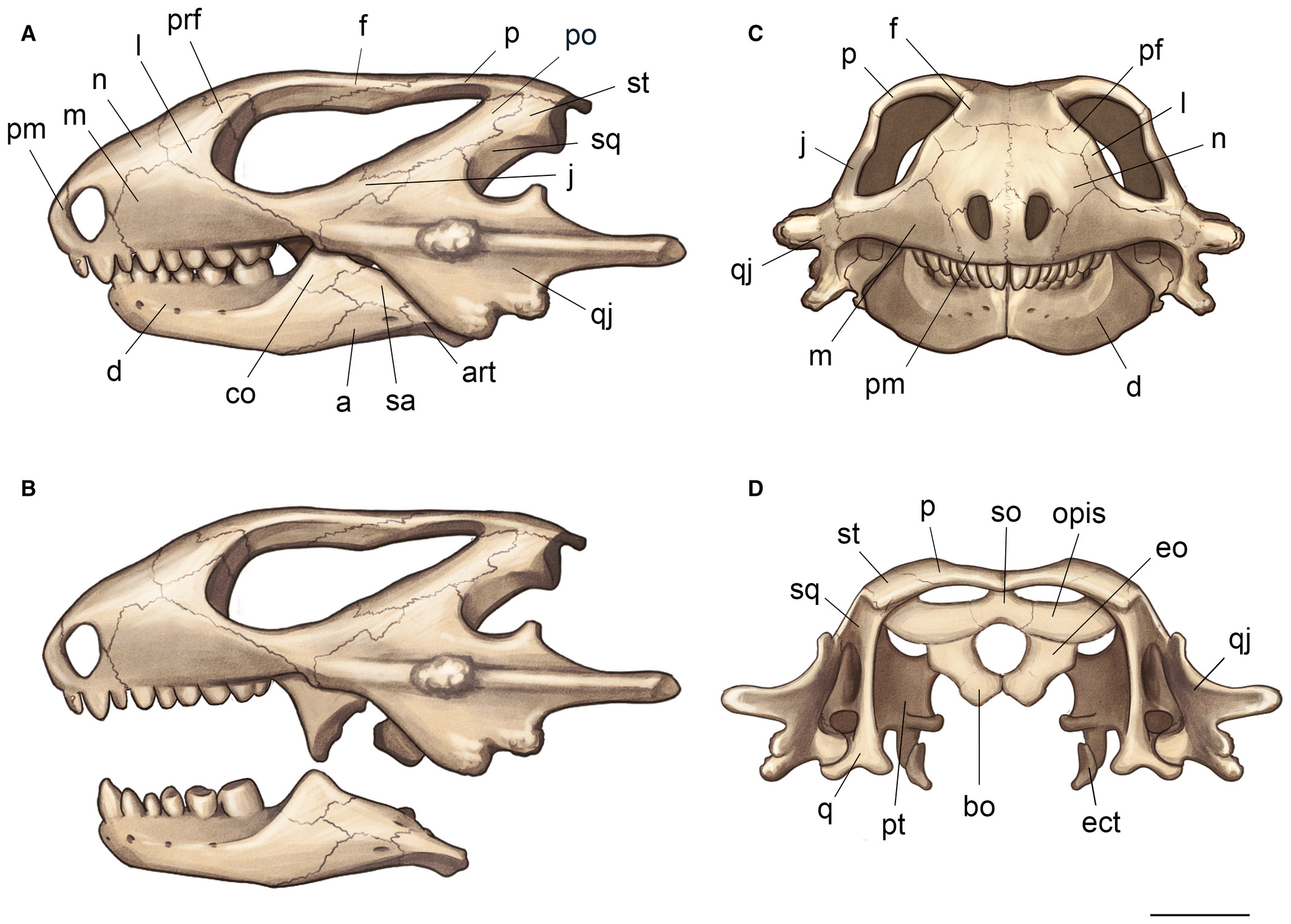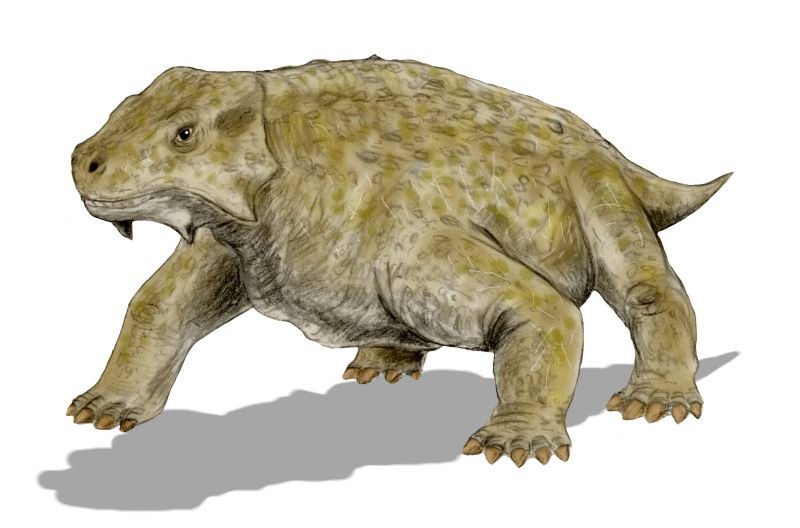|
Captorhinomorpha
Fossil of '' Labidosaurus hamatus'' Captorhinida (older name: Cotylosauria) is a doubly paraphyletic grouping of early reptiles. Robert L. Carroll (1988) ranked it as an order in the subclass Anapsida, composed of the following suborders:R. L. Carroll (1988), ''Vertebrate Paleontology and Evolution'', W. H. Freeman and Company, New York * A paraphyletic Captorhinomorpha, containing the families Protorothyrididae, Captorhinidae, Bolosauridae, Acleistorhinidae and possibly also Batropetidae * Procolophonia, containing families Nyctiphruretidae, Procolophonidae and Sclerosauridae * Pareiasauroidea, with families Rhipaeosauridae and Pareiasauridae * Millerosauroidea, with a single family Millerettidae. While they all share primitive features and resemble the ancestors of all modern reptiles, some of these families are more closely related to (or belong to) the clade Parareptilia, while others are further along the line leading to diapsid Diapsids ("two arches") are a clade of saur ... [...More Info...] [...Related Items...] OR: [Wikipedia] [Google] [Baidu] |
Labidosaurus Hamatus
''Labidosaurus'' (from el, λᾰβῐ́δος , 'forceps' and el, σαῦρος , 'lizard') is an extinct genus of reptile from the Permian period of North America. Fossils have been discovered in Texas. It was heavily built, resembling a lizard with a large head, and measuring about long. Unlike many other captorhinids it had a single row of sharp, conical teeth in its jaws, and its dietary habits are assumed to have been omnivorous. A lower jaw of ''Labidosaurus'' was described in 2011 that shows evidence of osteomyelitis, or an infection of the bone. It is the earliest known example of an infection in a land vertebrate. The infection probably developed because the pulp cavity of a broken dentary tooth was exposed to bacteria Bacteria (; singular: bacterium) are ubiquitous, mostly free-living organisms often consisting of one biological cell. They constitute a large domain of prokaryotic microorganisms. Typically a few micrometres in length, bacteria were among .. ... [...More Info...] [...Related Items...] OR: [Wikipedia] [Google] [Baidu] |
Procolophonidae
Procolophonidae is an extinct family of small, lizard-like parareptiles known from the Late Permian to Late Triassic that were distributed across Pangaea, having been reported from Europe, North America, China, South Africa, South America, Antarctica and Australia. The most primitive procolophonids were likely insectiovous or omnivorous, more derived members of the clade developed bicusped molars, and were likely herbivorous feeding on high fiber vegetation or durophagous omnivores. Many members of the group are noted for spines projecting from the quadratojugal bone of the skull, which likely served a defensive purpose as well as possibly also for display. At least some taxa were likely fossorial burrowers. While diverse during the Early and Middle Triassic, they had very low diversity during the Late Triassic, and were extinct by the beginning of the Jurassic. Phylogeny Below is a cladogram A cladogram (from Greek ''clados'' "branch" and ''gramma'' "character") is a dia ... [...More Info...] [...Related Items...] OR: [Wikipedia] [Google] [Baidu] |
Prehistoric Animal Orders
Prehistory, also known as pre-literary history, is the period of human history between the use of the first stone tools by hominins 3.3 million years ago and the beginning of recorded history with the invention of writing systems. The use of symbols, marks, and images appears very early among humans, but the earliest known writing systems appeared 5000 years ago. It took thousands of years for writing systems to be widely adopted, with writing spreading to almost all cultures by the 19th century. The end of prehistory therefore came at very different times in different places, and the term is less often used in discussing societies where prehistory ended relatively recently. In the early Bronze Age, Sumer in Mesopotamia, the Indus Valley Civilisation, and ancient Egypt were the first civilizations to develop their own scripts and to keep historical records, with their neighbors following. Most other civilizations reached the end of prehistory during the following Iron Age. T ... [...More Info...] [...Related Items...] OR: [Wikipedia] [Google] [Baidu] |
Prehistoric Reptile Taxonomy
Prehistory, also known as pre-literary history, is the period of human history between the use of the first stone tools by hominins 3.3 million years ago and the beginning of recorded history with the invention of writing systems. The use of symbols, marks, and images appears very early among humans, but the earliest known writing systems appeared 5000 years ago. It took thousands of years for writing systems to be widely adopted, with writing spreading to almost all cultures by the 19th century. The end of prehistory therefore came at very different times in different places, and the term is less often used in discussing societies where prehistory ended relatively recently. In the early Bronze Age, Sumer in Mesopotamia, the Indus Valley Civilisation, and ancient Egypt were the first civilizations to develop their own scripts and to keep historical records, with their neighbors following. Most other civilizations reached the end of prehistory during the following Iron Age. T ... [...More Info...] [...Related Items...] OR: [Wikipedia] [Google] [Baidu] |
Diapsid
Diapsids ("two arches") are a clade of sauropsids, distinguished from more primitive eureptiles by the presence of two holes, known as temporal fenestrae, in each side of their skulls. The group first appeared about three hundred million years ago during the late Carboniferous period. All diapsids other than the most primitive ones in the clade Araeoscelidia are sometimes placed into the clade Neodiapsida. The diapsids are extremely diverse, and include birds and all modern reptile groups, including turtles, which were historically thought to lie outside the group. Although some diapsids have lost either one hole (lizards), or both holes (snakes and turtles), or have a heavily restructured skull (modern birds), they are still classified as diapsids based on their ancestry. At least 17,084 species of diapsid animals are extant: 9,159 birds, and 7,925 snakes, lizards, tuatara, turtles, and crocodiles. Characteristics The name Diapsida means "two arches", and diapsids are tradition ... [...More Info...] [...Related Items...] OR: [Wikipedia] [Google] [Baidu] |
Parareptilia
Parareptilia ("at the side of reptiles") is a subclass or clade of basal sauropsids (reptiles), typically considered the sister taxon to Eureptilia (the group that likely contains all living reptiles and birds). Parareptiles first arose near the end of the Carboniferous period and achieved their highest diversity during the Permian period. Several ecological innovations were first accomplished by parareptiles among reptiles. These include the first reptiles to return to marine ecosystems (mesosaurs), the first bipedal reptiles ( bolosaurids such as ''Eudibamus''), the first reptiles with advanced hearing systems ( nycteroleterids and others), and the first large herbivorous reptiles (the pareiasaurs). The only parareptiles to survive into the Triassic period were the procolophonoids, a group of small generalists, omnivores, and herbivores. The largest family of procolophonoids, the procolophonids, rediversified in the Triassic, but subsequently declined and became extinct by the ... [...More Info...] [...Related Items...] OR: [Wikipedia] [Google] [Baidu] |
Millerettidae
Millerettidae is an extinct family of parareptiles from the Middle Permian to the Late Permian period (Capitanian - Changhsingian stages) of South Africa. The millerettids were small insectivores and probably resembled modern lizards in appearance and lifestyle. The following cladogram shows the phylogenetic In biology, phylogenetics (; from Greek φυλή/ φῦλον [] "tribe, clan, race", and wikt:γενετικός, γενετικός [] "origin, source, birth") is the study of the evolutionary history and relationships among or within groups o ... position of the Millerettidae, from Ruta ''et al.'', 2011. References External linksBerkeley University information. Permian reptiles Prehistoric reptiles of Africa Guadalupian first appearances Lopingian extinctions Prehistoric reptile families Parareptiles {{Permian-reptile-stub ... [...More Info...] [...Related Items...] OR: [Wikipedia] [Google] [Baidu] |
Millerosauroidea
Millerosauria is an order of Parareptiles that contains the families †Millerettidae and †Eunotosauridae. It is the sister group to the order Procolophonomorpha. It was named in 1957 by Watson. It was once considered a suborder of the disused group Captorhinida and was called Millerosauroidea. All members of this order are thought to be extinct. ''Eunotosaurus'' has been recovered as a stem-turtle in recent cladistic studies.Schoch RR, Sues HD (2015) A Middle Triassic stem-turtle and the evolution of the turtle body plan. Nature doi: 10.1038/nature14472. pub ahead of print A pub (short for public house) is a kind of drinking establishment which is licensed to serve alcoholic drinks for consumption on the premises. The term ''public house'' first appeared in the United Kingdom in late 17th century, and was .../ref> References * Parareptiles Prehistoric animal orders Guadalupian first appearances Lopingian extinctions {{permian-reptile-stub ... [...More Info...] [...Related Items...] OR: [Wikipedia] [Google] [Baidu] |
Rhipaeosauridae
Nycteroleteridae is a family of procolophonian parareptilians (extinct early reptiles) from the Middle to Late Permian of Russia and North America. They are sometimes classified as a sister group to pareiasaurids (but see ''Classification)''. The group includes the genera ''Macroleter'', '' Bashkyroleter'', ''"Bashkyroleter" mesensis'', ''Nycteroleter'', ''Emeroleter'', and probably ''Rhipaeosaurus''. They were carnivorous, and occasionally ate insects. The group was most common in European Russia, with only a few fossils in North America. One fossil has also been found in Africa, but this is the only one from Gondwana. Classification Nycteroleteridae is sometimes considered a sister group to the Pareiasauridae, but Bayesian inference suggests that it was in fact paraphyletic, with ''Rhipaeosaurus'' a basal member of the Pareiasauridae and other members of the Nycteroleteridae as outgroups. This is supported by the appearance of ''Rhipaeosaurus skull and teeth - it had tricu ... [...More Info...] [...Related Items...] OR: [Wikipedia] [Google] [Baidu] |
Pareiasauroidea
Pareiasaurs (meaning "cheek lizards") are an extinct clade of large, herbivorous parareptiles. Members of the group were armoured with scutes which covered large areas of the body. They first appeared in southern Pangea during the Middle Permian, before becoming globally distributed during the Late Permian. Pareiasaurs were the largest reptiles of the Permian, reaching sizes equivalent to those of contemporary therapsids. Pareiasaurs became extinct at the end of the Permian during the Permian-Triassic extinction event. Description Pareiasaurs ranged in size from long, and may have weighed up to . They were stocky, with short tails, small heads, robust limbs, and broad feet. The cow-sized species '' Bunostegos'', which lived 260 million years ago, is the earliest known example of a tetrapod with a fully erect posture as its legs were positioned directly under its body. Pareiasaurs were protected by bony scutes called osteoderms that were set into the skin. Their heavy skulls wer ... [...More Info...] [...Related Items...] OR: [Wikipedia] [Google] [Baidu] |
Sclerosauridae
Procolophonidae is an extinct family of small, lizard-like parareptiles known from the Late Permian to Late Triassic that were distributed across Pangaea, having been reported from Europe, North America, China, South Africa, South America, Antarctica and Australia. The most primitive procolophonids were likely insectiovous or omnivorous, more derived members of the clade developed bicusped molars, and were likely herbivorous feeding on high fiber vegetation or durophagous omnivores. Many members of the group are noted for spines projecting from the quadratojugal bone of the skull, which likely served a defensive purpose as well as possibly also for display. At least some taxa were likely fossorial burrowers. While diverse during the Early and Middle Triassic, they had very low diversity during the Late Triassic, and were extinct by the beginning of the Jurassic. Phylogeny Below is a cladogram A cladogram (from Greek ''clados'' "branch" and ''gramma'' "character") is a dia ... [...More Info...] [...Related Items...] OR: [Wikipedia] [Google] [Baidu] |




